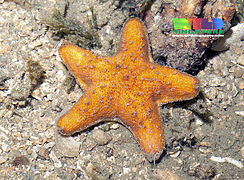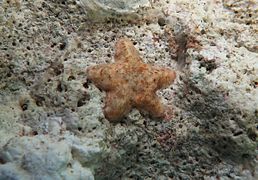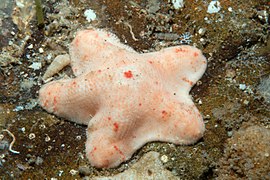
The Asterinidae are a large family of sea stars in the order Valvatida.
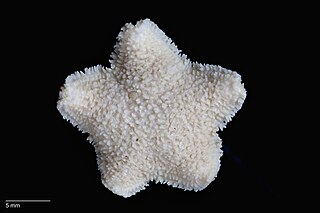
Patiriella is a genus of sea stars of the family Asterinidae. Many species formerly included in this genus have been transferred to other genera. They are commonly known as carpet sea stars.

Meridiastra calcar, formerly classified as Patiriella calcar, is a species of sea star in the family Asterinidae. It is endemic to Australia. It is commonly known as carpet sea star, cushion sea star, or eight-armed sea star.

Meridiastra mortenseni is a sea star of the family Asterinidae. It is endemic to New Zealand. Described as Patiriella mortenseni in 2002, it is named after T. Mortensen, who recorded it as distinct from Patiriella regularis, the New Zealand common cushion star, in 1925. According to genetic evidence, P. mortenseni was moved from the Patiriella genus to Meridiastra in 2004.
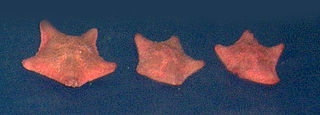
Asterina is a genus of asteroideans in the family Asterinidae.

Callopatiria is a genus of starfish of the family Asterinidae. The genus is found in shallow waters off South Africa, down to a depth of about 82 m (269 ft).
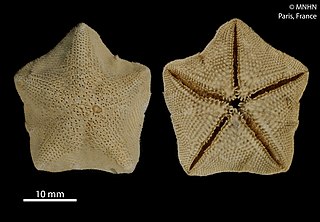
Cryptasterina pentagona is a species of starfish in the family Asterinidae. It is found in shallow waters in north eastern Australia. Its life cycle includes the release of large-yolked eggs and the development of planktonic larvae which is in contrast to the very similar Cryptasterina hystera which is viviparous. The two appear to have diverged from a common ancestral line only a few thousand years ago.

The Freyellidae are a family of deep-sea-dwelling starfish. It is one of two families in the order Brisingida. The majority of species in this family are found in Antarctic waters and near Australia. Other species have been found near New Zealand and the United States.

Nepanthia is a genus of starfish of the family Asterinidae. Members of the genus have four to seven rays and are found in the eastern Pacific Ocean, ranging from Burma and Indonesia to Australia.
Paranepanthia is a genus of starfish of the family Asterinidae. Members of the genus have five rays and are found in the waters around Australia, Indonesia and Antarctic New Zealand.

Aquilonastra conandae is a species of starfish from the family Asterinidae found near the Mascarene Islands in the Indian Ocean. It is known for its asexual reproduction and is fissiparous. It is a small starfish, discrete and camouflaged, and occurs in coral reefs in the surf zone of large waves. The species was described in 2006 by Australian marine biologists P. Mark O'Loughlin and Francis Winston Edric Rowe, and gets its name from Chantal Conand.
Chantal Conand is a French marine biologist and oceanographer.

Aquilonastra chantalae is a species of starfish from the family Asterinidae. Asterinid sea stars are typically quite small with an often pentagonal-shaped body, though there are exceptions. They are dorsally flattened and have short arms. The body's thin periphery is built up by very small marginal plates. One distinct characteristic of those in this family is the presence of an aboral face shaped by crescent-like plates.
Leptosynapta dolabrifera, the snot sea cucumber, is a small sea cucumber under the class Holothuroidea (1), in the family Synaptidae. It is most closely related to another species in its genus of 34 species Leptosynapta known as Leptosynapta inhaerens.

Aquilonastra burtoni is a species of small sea star from the family Asterinidae from the Red Sea which has colonised the eastern Mediterranean by Lessepsian migration through the Suez Canal, although the Mediterranean populations are clonal reproducing through fissiparous asexual reproduction. It was originally described in 1840 by the English zoologist and philatelist John Edward Gray.

Parvulastra is a genus of starfish belonging to the family Asterinidae. The species of this genus are found in Southern Hemisphere.

Ophiocoma erinaceus is an echinoderm, more specifically a brittle star of the Ophiocomidae family.
Asterina hoensonae is a species of pentagonal starfish in the family Asterinidae. The holotype was collected at Cape Agulhas, South Africa.

Cryptasterina is a genus of starfish belonging to the family Asterinidae. They occur in the Indian and Western Pacific Oceans in the littoral and shallow sublittoral zone.

Meridiastra is a genus of star fish in the family Asterinidae. The genus is found in the Indian and Pacific Oceans, with most records from the waters around Australia. They occur in shallow waters down to a depth of about 59 m (194 ft). Meridiastra are morphologically similar to the Atlantic genus Asterina. They are also phylogenetically close and possibly sister genera.





